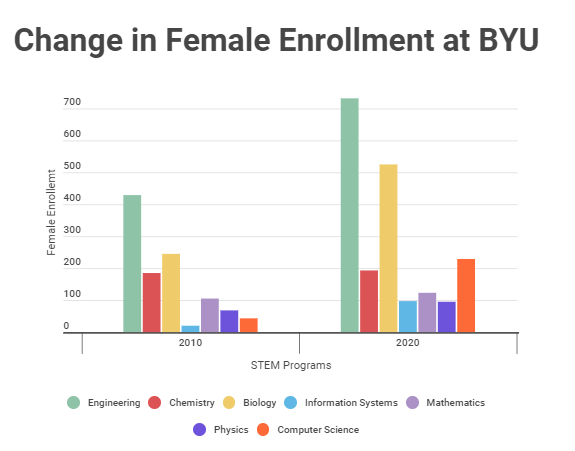
Statistics show female enrollment in STEM majors at BYU has increased over the past 10 years because of more awareness, opportunities and the supportive environments at BYU.
Including graduate and undergraduate students, data gathered from University Communications shows women now make up 24.1% of science, engineering, technology and math students at BYU in comparison to men who make up 75.9%. Women previously made up only 18.4%.
Though this difference may appear to be small, various majors within engineering, biology and computer science have seen a significant increase in female enrollment. Some colleges have also created new majors that have opened more doors for all students.

The National Center for Education Statistics found that 36.1% of those who receive an undergraduate degree in STEM majors in the United States are women. There is a difference in the data as BYU’s data includes graduate level work and the national level data does not. However, BYU still falls short with only 24.1% of STEM graduates being female.
“We are focused and concerned about making sure we help our women and other underrepresented groups thrive in our college. We are seeking to improve in any way that we can,” said Nicole Stewart, a BYU Women in Engineering coordinator. The organization continues to fight factors that draw women away from STEM.
College of Engineering academic advisor Bryan Bowerman explained this increase of enrollment could be attributed to the way modern culture advertises STEM-based careers. He has seen how STEM majors are now more appealing to all genders.
“Certain stereotypes in the way careers were presented have diminished so there are fewer gender-assigned subjects and areas of study, and that’s not just a BYU thing, but rather a world-wide trend,” he said.
Stewart and Bowerman said this increase in enrollment can be correlated to a number of factors, including an increase in exposure to math and science opportunities from grade school through college as well as encouraging and supportive environments. While these factors reflect an increase, women at BYU still struggle to keep up in comparison to the nation.
What holds women back?
Women have not always had the same exposure to math and science as they do now.
In recent years, K-12 schools have created opportunities “in which a broader diversity of students are exposed to math, science, and engineering subjects,” Bowerman said. The more students are aware of STEM field opportunities, the more they recognize their options.
BYU engineering student Kayla Lyman knows plenty of women who have the capability to work in STEM but lack the interest in STEM subjects. “If we could expose people to it younger and make it interesting and relevant to them, that would help increase female interests in technology,” she said.
Bowerman recognized the work done by the College of Engineering to increase outreach to female students, encouraging them to consider engineering-related fields. Groups such as Women in Engineering at BYU often readily converse about the “reality of a STEM career for women at BYU.”
Lyman said her peers are often married men who have no interest in being in a study group with her. However, she said she is confident electrical engineering is where she belongs because she is passionate about what she is learning.
Stewart has started to notice an increase in concern of impostor syndrome among female engineering students in recent years. To combat these feelings of impostor syndrome, Lyman practices positive self-talk to remind herself that she is finding success where she is, and not everyone knows exactly what’s going on all the time.
“I have to remind myself that I’m getting good grades, I’m doing research and I belong here. This is something I want to do, and I can do it,” Lyman said. She is also a member of Women in Engineering and Women in STEM at BYU and said she is grateful for the support she finds through those clubs.
Many women, especially at BYU, may feel they need to choose between being a mother and pursuing a career. Physiology and developmental biology major Olivia Stubbs initially struggled with the idea of investing so much time and energy into her education and career if she were just to put it aside and be a mother. More recently, she said she realized she doesn’t need to choose.
“My plan is that I am capable of doing both, so I am not going to make myself choose between doing one or the other. I think I can make it work,” Stubbs said.
What propels women forward?
Women are developing the confidence and finding the support to succeed in STEM and find purpose in their majors and future careers. Stewart said she has noticed women’s concerns about a STEM degree and career being compatible with families. “We have several events each academic year to address this concern.”
Just as greater exposure to math and science for girls in grade school has impacted their awareness of opportunities, there are many groups and events on BYU campus that promote and encourage female participation in STEM.
These resources and groups have not always been available to students. Their establishment over the past 10 years has provided awareness of opportunities and support for women in STEM.
“During these events, female students can hear what other women in their fields are doing to manage work and family. Some students are surprised to hear how many companies are revising policies, for women and men, to make careers more compatible with families. Also, some companies provide incentives and support for employees to earn an MBA or graduate degree,” Stewart said.
These groups on the BYU campus include: Women in STEM, Women in Engineering at BYU, Women in Computer Science, Women in Chemistry and many others.
“The (Women in Computer Science Club) functions as a vehicle and a place to gather for people who might be struggling with similar problems or may need other people around that they feel they can connect with,” said Xinru Page, advisor of the Women in Computer Science club.
In Page’s own experience throughout her studies, she’s noticed “having (female) role models and others that you feel comfortable speaking with is really important.”
BYU student Olivia Stubbs knew she wanted to pursue a career in the medical field and was confident she could make a career in STEM happen, despite the challenges. Through the Association of Future Female Physicians, Stubbs had the opportunity to attend a round table discussion with a current female medical student and a physician where the undergraduates spoke in a small group about the guests’ journeys.
“That was by far the most powerful event and most exciting event that I have been to that made me feel like, ‘I got this, if they can do it then I can do it and it’s all going to work out,'” she said.
These clubs provide opportunities of strength and empowerment for students when they are often clouded with doubt. Bowerman said groups like these help female students see the potential fit of a STEM related degree.




